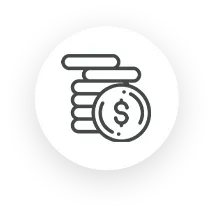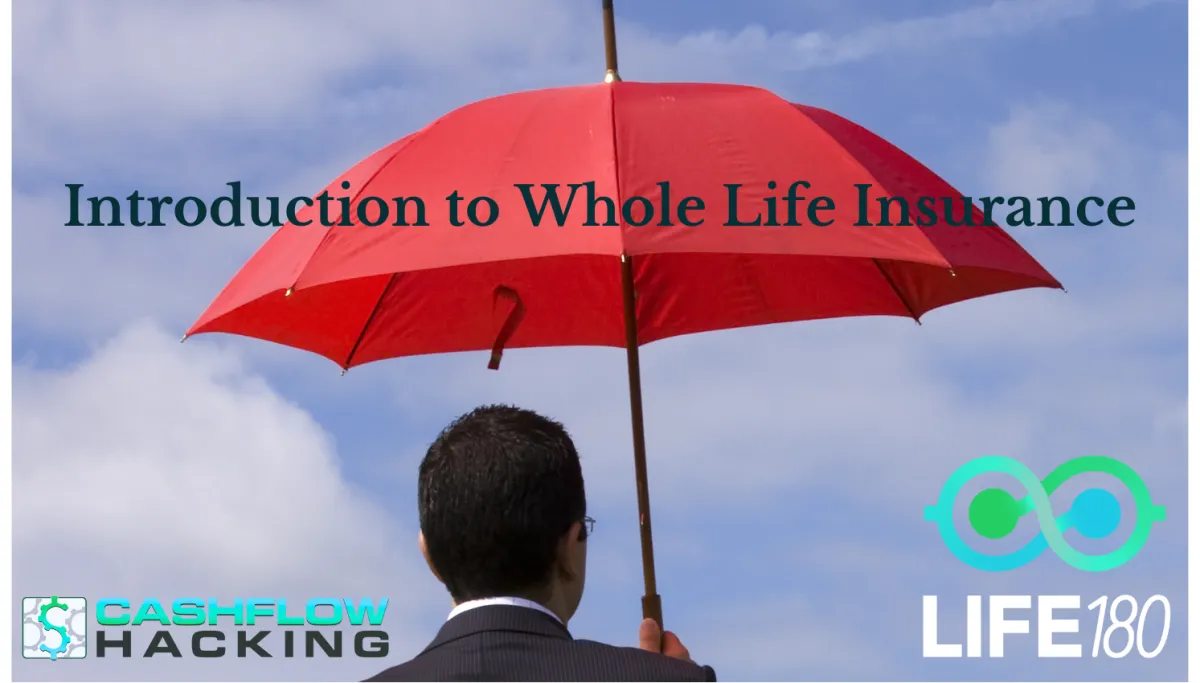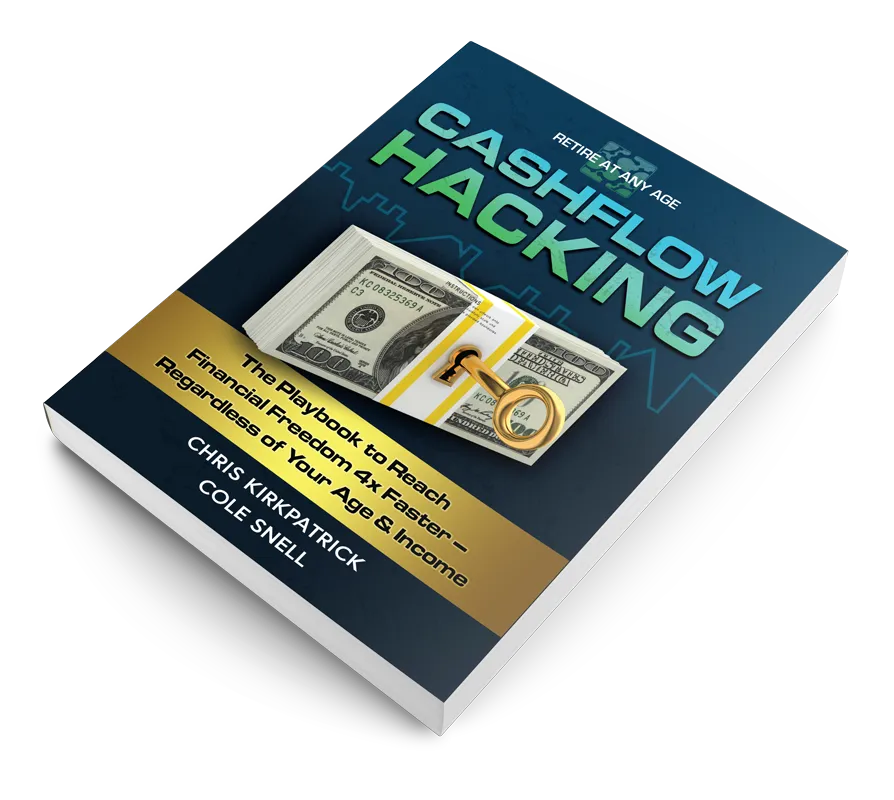
Simplifying Financial Confusion
LEARN CASH FLOW HACKING TO REACH FINANCIAL FREEDOM
Used by 90% of millionaires to reach their financial goals 4x faster

Achieve Financial Freedom Through Cash Flow Hacking

Increase Your Lifestyle While You Build Your Wealth

Position Yourself to Thrive in Market Downturn
YOU SHOULD NOT FEEL OUT OF CONTROL ABOUT YOUR FINANCIAL STRATEGY

Have easy access to your money in case of emergencies and opportunities

Use the investment strategy 90% of millionaires use

You deserve a clear plan to consistently grow your money and avoid market uncertainty

Have a guide and advisor that has your best interest in mind

Do not overpay in taxes

Stop guessing at the best vehicles to protect and grow your money

Introduction To Whole Life Insurance

Below is a transcript of the YouTube video that you can find on the LIFE180 YouTube channel.
Whole life insurance is a wildly misunderstood product. It is one of those products that you either love or hate. People like Dave Ramsey and Suze Orman swear that whole life insurance is the worst financial product on the face of the Earth, while at the same time, some of the most successful financial stories in American history – like the creation of Disney and McDonald’s, for example – were only able to occur because Walt Disney and Ray Croc used whole life insurance as a storage vehicle for their cash.
How To Avoid The Downsides Of Whole Life Insurance
However, it’s not all rainbows, unicorns and glitter when it comes to whole life insurance. As much as I love whole life when it is designed the correct way and utilized to fulfill the proper function in your personal finances, there are a lot of downsides you have to avoid. These are the downsides that the likes of Dave and Suze are trying to protect people against.
From that perspective, I get it, I would have to agree with Dave and Suze. The good news is that all of the downsides are completely avoidable and if you work with a life insurance professional who understand your goals, wants, needs, and objectives, a properly designed whole life policy can be one of the most powerful assets in your life.
You are probably thinking to yourself, “Chris, that’s a pretty bold statement”. And to that thought, I would agree, it is a bold statement! But, it is a bold statement I am willing to stand behind. Let me explain.
If you watch the LIFE180 YouTube channel at all, you know I talk a great deal about whole life insurance because I love it so much. But you also know that I am not a huge fan of pushing products. The reality is, the reason I love whole life insurance so much is simply because when we get away from product names, investment strategies and talking heads (including myself), all that matters is your goals, your values, and your beliefs.
Focus On The Attributes Of Whole Life Insurance
So, in the interest of keeping this as straightforward as possible, I am going to focus more on the attributes of the policy. Let’s not talk about whole life insurance. Let’s talk about YOU. Your values, your beliefs, your goals. What do you want to happen in your life and how do you align your money with your values and beliefs to help accomplish those objectives with more certainty?
The Basics Of Whole Life Insurance
Whole life insurance has three components to it that matter to most people.
The death benefit
Cash value access (banking/savings alternative)
Living benefits through accelerated death benefit riders
So let’s go through those three components in order, breaking down how they can all impact your financial life and your families finances for potentially generations to come.
How The Death Benefit Works With Whole Life Insurance
Death Benefit
When most people think of any type of life insurance, the natural place to start is the death benefit. In fact, I think most people actually think about life insurance as death insurance. There is so much more to whole life insurance than the death benefit, but I will get into that soon. For now, let’s talk about the different elements of a whole life policy that impact the death benefit. There are four components the death benefit:
Your health & age
Base whole life insurance premium
Paid Up Additions (PUA’s)
Term Insurance Riders
Of course, your health is the foundation of everything. I always tell people that owning a whole life insurance policy is a privilege. It is not promised to you. You need to qualify for it. Even if you do qualify for life insurance, there ratings that exist that determine your cost of insurance:
Preferred Plus
Preferred
Standard
Substandard (table B-F)
Smoker
Remember, insurance is about managing risk. The healthier you are, the lower the costs. It is absolutely essential that the life insurance company understands your health and the potential risks so they can assign a rating to it. That rating along with your age will help determine the cost of insurance (COI).
Base Whole Life Insurance Premium
There are several ways you can come to a death benefit calculation. The traditional way of selling whole life insurance is to determine the death benefit desire and determine the premium based on the life insurance. It is this way of designing life insurance that makes Dave Ramsey’s head explode.
When you use 100% base premium on whole life insurance, the costs are pretty high. While using a 100% base whole life policy makes sense for some people, it is a very small percentage of the population (IE: higher net worth segment) that would use it for legacy and tax planning.
What Should Be Included In Your Life Insurance Policy?
In reality, every whole life insurance policy should have a blend of three things:
Base whole life insurance premium
Paid up additions
Term insurance rider
There are other riders you can add, like guaranteed insurability riders (love these for kid policies), and waiver of premium riders, but I am not going to focus on those right now.
How To Determine Your Whole Life Insurance Premium Payment
Now that you know the three components that need to be included in every whole life policy, now it’s important to understand how to determine the premium payment. This is where it gets tricky and I have a lot of videos talking about the topic because it is more complex than one would think.
To keep it simple, just start with a number that you can save every month. Pick a dollar amount that stretches you and forces you to save, but not so much that it stresses you out. It is my belief that any money you would keep in a long term savings account for emergencies or opportunities would be more efficiently saved inside of a whole life insurance policy. You will understand why soon!
My overriding belief is that people should keep two years of income in guaranteed, liquid assets in case of emergency or opportunity. One year of income for emergencies and one year of income for opportunity planning. So, if you make $50,000 per year, the goal is to get $100,000 into a guaranteed financial vehicle – of which, my preferred financial vehicle is a whole life policy.
Let’s say the goal is to have that $100,000 in the next 10 years, that means you should be saving about $10,000 per year to get there.
Assuming the $10,000 per year premium, now we need to determine the blend of base insurance, PUA’s, and term insurance used.
I always tell people, there are no free lunches with life insurance. It is ALWAYS a give and take. The higher your base insurance, the lower your liquidity or cash value access will be in the first several years. This is obviously a big deal if you are needing that money for emergencies.
The lower the base and the higher the PUA’s in the policy, the more early liquidity you will have. However, the long term growth will typically be reduced by a little. In addition, the higher the blend of PUA’s you use, the larger the term insurance rider will need to be to keep the contract from becoming a Modified Endowment Contract (or MEC).
What Is A Modified Endowment Contract (MEC)?
What is a MEC, you ask? It is a formula that the government created back in the early 80’s when they created qualified plans, like the 401k. Essentially, before they created the MEC rules, you could jam as much money into life insurance and keep all of the tax free benefits you wanted. But when they created qualified plans, they knew they had to limit the tax benefits of life insurance, otherwise you would never put your money into their 401k’s.
When you hear someone talking about “max funding” a whole life insurance policy, what they are really saying is that they are funding it up to the MEC limit to keep the tax benefits.
Now, I am a big believer that if the government is trying to limit your ability to contribute to something, there must be a reason – and that reason isn’t for your benefit. So I am going to max that out.
What we do is we create our own MEC – a Maximum Efficient Contract! The perfect blend of base premium, PUA’s and term insurance to focus on cash efficiency in the policy.
While I think every whole life insurance policy should be designed for maximum cash efficiency, I also believe that we shouldn’t dismiss the importance of having the amount of life insurance your family needs. Be sure to supplement that insurance desire with a good convertible term insurance policy – which will keep your insurance costs down!
The Perfect Whole Life Insurance Policy Design
I have news for you, this doesn’t exist. Life doesn’t exist on a spreadsheet. Life happens in the world. I don’t believe whole life insurance is a product that should be sold on a spreadsheet because if that is what you are doing, you are likely not considering all of the variables.
There are some people that swear the only way to design a policy is with a 40/60 blend. That means 40% base whole life insurance and 60% PUA’s. When you design a policy like that, the insurance company will determine how much term insurance is needed to allow the PUA’s (more cash) to be added to the policy without MECing. Nelson Nash made the 40/60 blend extremely popular with his Infinite Banking Concept philosophy.
Other people will sell you on the fact that a 10/90 policy is the best blend with 10% base insurance and 90% PUA’s. On the other side of the spectrum, there are purists that believe 100% base policies are the best way to go.
I have many videos breaking down all of those concepts, so to keep this video straightforward, I will tell you what I believe. I believe that the best policy design for YOU is the policy design that meets YOUR goals and objectives. Each person has their own unique personal finance ecosystem. Each person has their own priorities. In order for you to know which design is best for you, it is essential that you are 100% clear on your values and beliefs so you can reverse engineer a financial strategy to be congruent with those values and beliefs. You can’t spreadsheet this stuff UNTIL you are clear on that.
Living Benefits Inside Of Whole Life Insurance
It’s called whole life insurance because as long as you pay the premium, the benefit of having this policy will be with you for your entire life. For this reason this represents a financial tool for your whole life. And it isn’t just about the death benefit. The living benefits are just as important to most people. Let me elaborate.
As we go through life, our needs change. When we are young, we need to save money and build our financial foundation for the future. Then we get married and have kids. Life becomes a bit more complicated with more responsibilities. Our needs and wants change as we grow our families. Then comes retirement and ultimately, there is no getting out of this life alive…
I think for anyone who thinks long term, whole life insurance becomes a NO-BRAINER! It helps you in every stage of life. Let me elaborate briefly.
In your 20’s and before you have a family, it’s important to save money. Well, whole life insurance is the best forced savings vehicle on the planet. It builds in a self-discipline plan for you when you are probably at the least disciplined age of your life. Long term, whole life insurance will outperform your savings account, CD’s and bonds. At the same time, you will have a very high percentage of liquidity IF you follow my advice on how to design it from earlier.
The amazing thing about this is that, typically you are never healthier than you are in your 20’s. You are also never going to be younger. That accomplishes one amazing thing – CHEAP INSURANCE. By getting ahead of insurance in your 20’s (or by doing this for your kids if you have the resources), you are checking several lifetime financial needs off the box.
Your emergency and opportunity savings fund
Life insurance to protect your family
Of course, there is a high likelihood that you don’t have a family yet in your 20’s. But you probably will have one at some point. Why not guarantee their quality of life before they are even here? It’s more efficient than saving in a bank AND it will save you money on insurance since you are buying it a decade sooner. It’s just good planning and it is the NUMBER ONE thing I wish someone had taught me when I was in my 20’s.
You then get married and start having a family. You have different focuses now. Financial stress of kids, saving for college, investing for your retirement, and more. The good news is that having your policy in place for a decade at this point (or even if you are just starting one) will put you in a far better position.
Any cash value you have in your whole life policy can be used for emergencies, of course. But the part I love most is what I call Cashflow Hacking – the process of using the cash value in your whole life policy to invest in cashflowing assets (like real estate). It’s not for everybody, but for people who have a leaning to entrepreneurship and real estate investing, there isn’t a more powerful product in the world than a properly designed and mature whole life insurance policy.
Whole Life Insurance For College Savings
As you hit your 40’s and 50’s and your kids head off to college, hopefully you have saved as much for college in your whole life policy. In fact, ideally, you would have gotten your children their own whole life policy to save in. A properly designed policy is a great alternative to a 529 college savings plan. In most situations, the amount of money in your whole life policy is not used against you when calculating your expected family contribution. That’s a huge deal if you haven’t had to deal with it yet. If you have, you know what I am talking about.
How Whole Life Insurance Will Help You In Retirement
Then comes retirement, a word that I hate. In fact, I am on a mission to get people to stop using it and just create enough cash flow to be free so you can show up as the highest version of yourself in the world. While that’s a battle I am willing to fight, I know I can’t save everyone.
Either way, as we age, we become more vulnerable to health issues. Did you know that medical bills are the leading cause of bankruptcy and financial struggle in retirement? Did you know that you have over a 70% chance of needing assisted living before you die? Did you know that most people don’t think about these realities or try to deal with these facts until it is too late?
Long term care insurance is EXTREMELY EXPENSIVE – especially if you wait until your 50’s to address it. Remember I said that whole life insurance is going to help you in every phase of life? Check this out!
If you get the right type of whole life insurance policy, it will come with the ability to accelerate a portion of your death benefit to cover medical treatment and bills if you are diagnosed with a chronic or terminal illness. This money can be used to pay for assisted living, long term care, or other medical treatments.
This topic is something that in the past I always downplayed. After all, I am human and while I was in my 30’s I couldn’t really grasp the reality of health issues later in life. Then my father in law was diagnosed with Pancreatic Cancer and given 90 days to live.
I remember the oncologist telling him they could probably get him to a year, but his quality of life would be horrible. Long story short, we decided against those treatments. We decided to go the more natural route with alternative treatments. Treatments that insurance companies wouldn’t pay for. Treatments that cost over 6-figures out of pocket.
The good news? Two years later, my father in law is still playing golf three to four times a week and able to hang out with his 3 grandchildren virtually every single week!
The tough part is that most people don’t have the planning or the resources to come out of pocket with 6-figures of medical expenses to fight for their life. If you have whole life insurance as part of your plan, it changes all of that.
Life Insurance Is The Most Tax Efficient Financial Tool On The Market
Then of course, as we pass on to the next life, the one thing almost every personal finance expert can agree on is that there is no more efficient way to pass money to the next generation than through life insurance.
It’s for these reasons that I tell all my clients that having whole life insurance as the foundation of your financial life is the only way to create a “self-completing plan”. What you want to happen, will happen, when you want it to happen – even if you are not here to see it.
When you think about what you want in life, when you contemplate how you will feel on your deathbed… Thoughts about your family, your relationships, your legacy, how you showed up in this life, and much much more. If you close your eyes and visualize your life, how you lived it, what you created, and how you want to be remembered, can you think of another product that will help you in a fraction of the amount of ways that whole life insurance did?. I would venture to say NO. And that is why I am so passionate about this product and educating as many people about it as possible.
I hope you found value in this and I hope it opened your eyes to think just a little bit differently about money and your long term planning.
Have a blessed and inspirational day!
HOW TO START TAKING CONTROL OF YOUR FINANCES BY MAXIMIZING YOUR CASH FLOW AND PROTECTING YOUR ASSETS

1. Schedule Your Free Clarity Call

2. Create a Free Customized Plan

3. Get Guide to Financial Success
GET YOUR FREE COPY TO STOP USING OUTDATED RETIREMENT STRATEGIES
Cash Flow Hacking teaches you to:
Protect Your Investments
Thrive in bad markets
Reach financial freedom faster

ARE YOU LOOKING FOR:

Cash Flow Hacking teaches you to:
Security to protect your money
Increased cash flow and lifestyle
Inflation protection
Financial certainty in all economic environments
A reduction in taxes
Safe and fast access to your money with no penalties
WHO IS THIS PROGRAM FOR?

People looking for an alternative
Are you looking for alternatives to Wall Street’s “buy and hold” strategy that takes 40 years with uncertain results? Our Cash Flow Hacking strategies provide you the building blocks to get started on the right foot

Passionate Entrepreneurs
Are you looking for a financial strategy that will take your best assets (you and your businesses) and multiply their potential? Our Cash Flow hacking strategies will teach you how to invest for the future without sacrificing building your business

Real Estate
Investors
Are you a real estate investor who is burned out from being a landlord or playing the fix-and-flip game? Our Cash Flow Hacking strategies will provide you with the system to create predictable wealth AND give you the freedom you are looking for.
YOU DESERVE PEACE OF MIND AND A PLAN THAT WILL PROTECT YOUR FAMILY AND GROW YOUR WEALTH
Today you need to be more savvy than ever if you try to go at it alone.
Losing money to inflation, taxes, and just poor investment strategies is leaving you frustrated, feeling out of control and not knowing where to turn. To add to the problem, the market is flooded with advisors who have outdated advice that does not place your best interests first, but instead focuses on charging you a fee that creates guaranteed cash flow for them.
NOT YOU
We believe this is wrong and that your security and best interests should be placed first. We believe you should be in a position where you control your money, your money doesn't control you. We understand because we talk with hardworking people everyday that are losing money in the markets based on old information and feel like they are guessing at the best course of action.
We created the Cash Flow Hacking plan to help you have security and control of your money to take advantage of life's opportunities because you deserve peace of mind with your wealth. The old way of planning for retirement of… Go to school Get a job & save as much as you can in your 401k and mutual funds...is broken.
You have been lied to. Think about it, where else in life does someone tell you that the most certain way to achieve your desired result is to take on more risk? The math just doesn't work, and the results are showing in our country and world. Did you know that 90% of millionaires in the United States have 1 asset in common?
Hint: it's not stocks or mutual funds (and no...it's not crypto) How much sense does it make for you to work hard, save money, reduce your current lifestyle (because that's what you are doing when you save for the future - taking money you could use on lifestyle today and delaying gratification to a future unknown time), and hope that whatever you are doing will work three to four decades from now? If you're thinking, "not much sense at all…", you are in the right place.
With over 50 years of experience on our team, we have worked with thousands of individuals and families to achieve financial freedom faster and with more predictability by helping them invest for Cash Flow.
How does the Cash Flow Hacking Plan work? 1. Take the Cash Flow Hacking Challenge 2. Complete the LIFE180 X-Ray and determine what your Freedom Number is 3. Work with a Cash Flow Hacking expert to provide you a customized plan
The customized Cash Flow Hacking plan will give you clarity on where you are now, where you want to go (and in what time frame), and what you need to do to get there predictably.
We value and commit to you: We believe you deserve the best financial education and guidance We believe financial decisions should not be rushed but be well thought out with a plan We believe you should be in control of your money We believe we earn your trust through time, education, and proper due diligence Without a proper plan and guidance, your money can be lost to taxes, inflation, and bad investments You deserve more with the most up-to-date strategies to mitigate your risk, control your money, and earn stable returns regardless of the market Schedule a call here to attain your LIFE180 Financial X-Ray now or get started with the Cash Flow Hacking Challenge for free.
I am interested in...